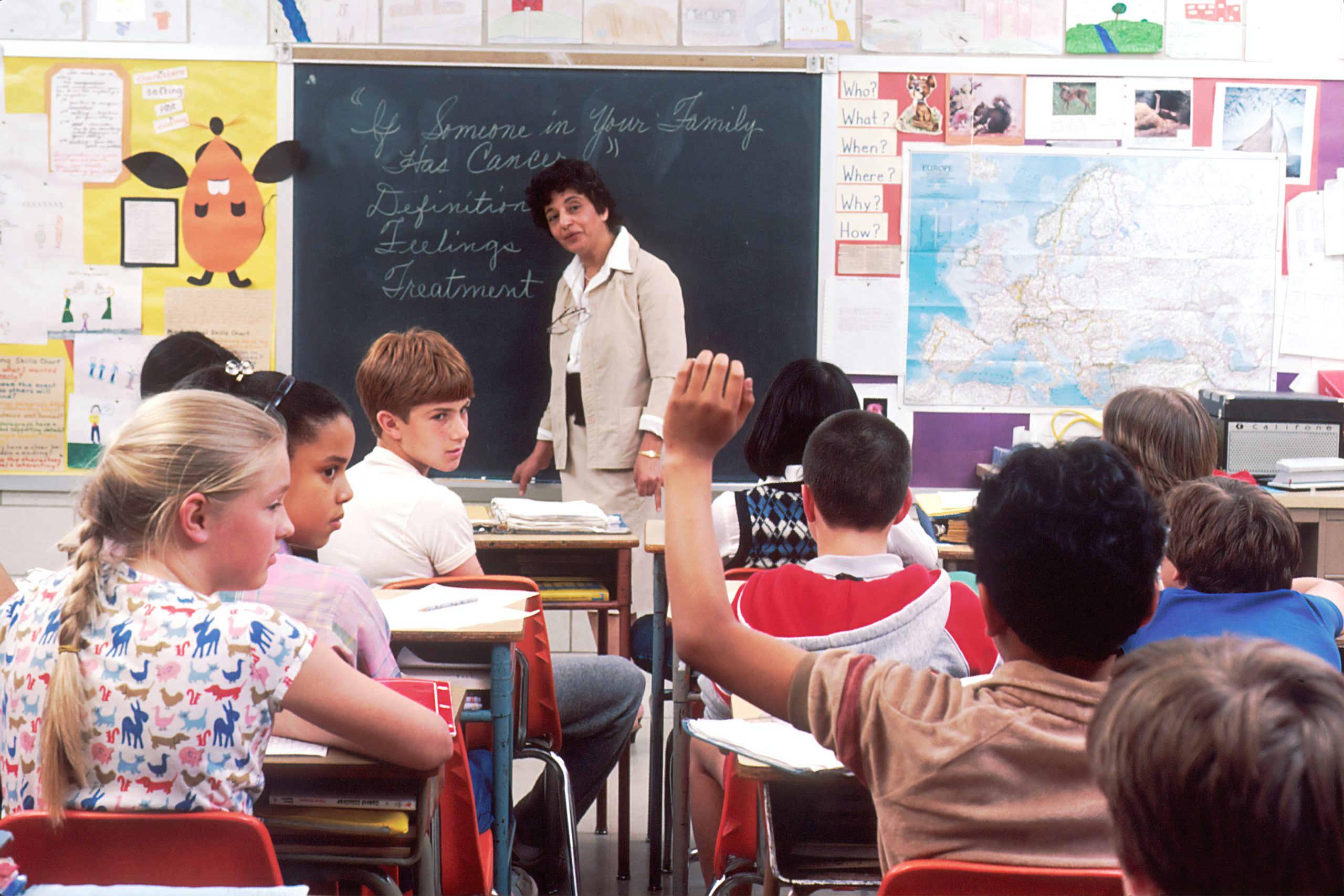Table of Contents
How do teachers at your school refocus a class that has gotten out of control? How can a teacher set firm expectations and yet keep a positive classroom culture?
This five to ten minute professional development article will guide you or your school through a common school scenario and pose questions for discussion and reflection on how you have responded to similar situations in the past and how you hope to improve for the future.
All scenarios are fictitious, but meant to represent categories of difficult classroom situations teachers are often faced with. Read to the end of the article for suggested interventions based on current neuroeducational research.
The Situation
“Whoever is still talking when I count to five is getting a detention! Five…four, Johnny, butt on the chair, you’re going to get a concussion sitting like that, three… two…Johnny!” The teacher’s panic grows as the head of school walks in the door and quietly raises a finger. However, to their surprise, the class instantly quiets down, raises their fingers in response, and Johnny even has his butt firmly in his chair.
“Sarah, your mother is here to pick you up. Taylor, you still owe me your permission slip for the trip. If I don’t have it by Friday I’ll have to remove you from the list. Johnny, you left your crutches in the lobby, don’t walk around on that leg yet without these.” Each child diligently said “Ok” in turn and no one else spoke. “You all be good for your teacher, see you at dismissal!” and the head of school was off. There was a slight mutter as the door closed, but the class was back and ready to learn.
Suggested Interventions for Positive Classroom Culture
While a school classroom is probably never going to match the level of peace and zen achieved at a yoga class, there are several ways teachers can bring quiet to the room in a way that is calm and doesn’t add to teacher or student stress. Many of them may seem to not produce results immediately, but by slowly integrating these practices, teachers will see their classroom culture change day by day as students get used to the new routines.
1: Don’t shout over students.

Generally it is best to use a quiet voice rather than adding to the noise by yelling over the students as “The children will quiet the environment as they try to hear your voice.” (Parks) While it may seem impossible to get any attention at all over the roar of the students chatter, there are several strategies that can work without teachers using a word.
One common strategy is for teachers to teach students that when they put their hands in the air or on their head, students should do the same and be quiet. As more students notice everyone raising their hands or putting their hands on their head they will all begin to quiet down and follow suit.
This hand motion can be accompanied by a call by the teacher for quiet that the students respond to such as “Hands on top!” being said by the teacher signals students to put their hands on their heads and say together “That means stop!”. This approach does add to the noise however, and is only appropriate for younger students. Generally simply saying “I’ll wait until everyone is ready.” will be enough to eventually quiet the room after a few seconds of conversations finishing.
For older students, the teacher should focus on quiet visual strategies to keep the classroom noise from escalating. Another visual strategy that can be used in many classrooms is the lights. Flashing the lights on and off gives a very clear and noticeable visual signal to the class that it is time to quiet down and move on to the next activity.
While it can be stressful and frustrating when students won’t listen and seem to ignore instructions, it is important to not add to the classroom problems by simply trying to out yell the class. Creating these norms of behavior to quiet down takes time, but once students learn the drill, it will make for much smoother transitions and a more peaceful experience for students and teacher in the long run.
2: Give clear limits and be firm.
Part of setting and making these quieting strategies effective is by implementing them as early in the year as possible and giving clear explanations as to what happens if students don’t quiet down once the teacher has given the signal. Punishments should be light, but consistent. Moving the student to a different seat, having the student stay after class, or depending on their age, losing recess time are all small but clear signals to the student that they need to listen and respect the classroom culture.
3: Ensure lecture time is efficiently organized and heard by all.
One of the clear limits that students should be that all students remain quiet and in their seats when the teacher is giving instructions. This is important because not only does it help to set the classroom culture to one of respectful listening, but it helps smooth communication and transition between activities. If all students are able to clearly hear the instructions, they will need fewer reminders of what to do and will know when it is time to move on to the next activity.
Visual distractions of students moving around or acting inappropriately can take student attention and prevent them from properly hearing instructions just as much as noises. Having these times of quiet focus on the teacher will also allow the teacher to help students develop their abilities to remain calm and focused.
All of the responsibility for this isn’t on the students however, as all they need to do is quietly listen. The teacher needs to ensure they are being respectful of students’ time and their hard earned attention. Teachers expect student presentations to be well planned, timed, and spoken clearly, and the same should be expected of the teacher’s presentations.

Before signaling students to quiet down, the teacher should write the instructions they plan to give on the board clearly in large print. Then, once the teacher has prepared what they are going to say, they quiet down the students using one of the above strategies and use their written list of steps to ensure students not only hear the instructions, but can see them, activating a second sensory pathway in the students’ brains.
Additionally, students can refer back to the written instructions if they get lost or forget a step as they complete the activity independently. This minimizes the number of times students need to be quieted and given instructions and also has the benefit of reducing student questions of what to do when one step is complete.
4: Keep a positive demeanor, but don’t be a robot.
While punishments are often necessary in order to set a consistent classroom culture, they should never be given out in anger or frustration. This can escalate bad feelings and make the punishment feel more personal to the student. This doesn’t mean that the teacher should turn into a complete robot and not show any emotions, however.
Research shows that students respond best to expressions of emotions they feel to be genuine. So while the teacher should try to avoid anger, other tones of sadness or even hurt feelings can help students to see how their behavior can make others feel and that adults are human beings too. Students need to realize that their actions have an impact, but teachers need to model how best to respond to frustration for their students even in the times they have to give out punishments.
5: Share authority with students.
Research done at a school in the American Midwest for Somalian refugees found that they got the best results in helping students acclimate to the new classroom culture by sharing responsibility for the classroom culture with other students rather than having the teacher be the sole source of authority in the classroom. The way this can be done is different for different age groups, but in the end, the goal is the same; to get students invested in their classroom rather than feeling trapped by it.
One way to achieve this with younger students is by assigning classroom jobs. These jobs don’t have to be complicated, but should be centered on giving students a share of the responsibility for how the classroom looks and sounds. Line Leader, Paper Distributor, Board Cleaner, Pencil Sharpener, or Library Organizer are just a few of the possible jobs students might be able to do to take responsibility for taking care of the classroom.
Some of these jobs will be coveted by students and so the teacher can use them as an incentive for good behavior. If all of the students want to be Line Leader, the teacher can say that whoever has good behavior this week and is quietly in their seat will be next week’s Line Leader. This will give students encouragement throughout the week to keep on their best behavior so that they get their favorite job as often as possible.
For older students, teachers should focus on sharing speaking time so as not to dominate class time with their own voice. As students mature, they will want to take the reins more often and that can be done by the teacher challenging themself to speak as little as possible during class time. The end goal of school is for students to be able to lead their own discussions, present their findings from research to their peers, and independently learn and achieve their goals.
Teachers should try to give older students projects and activities that they can do largely without long lectures. As they do their work on the project, there should be check-in periods where they come to the teacher to have their work assessed, discuss ideas to improve, and little nuggets of wisdom can be given to help students along in their work. They can then receive the next set of instructions and move forward in their work.
In this model, the teacher’s time is valuable to the student as they need to discuss their work at various stages of completion, but crucially, they get to choose when that is. Trying to mass disseminate information to all students simultaneously will inevitably result in many not being ready for the information yet. If teachers let students come to them when they are ready to implement some piece of learning into their project, not only will they be better prepared to learn, but the one on one student teacher ratio is significantly better for keeping student attention than a big lecture.
Though admittedly, this approach does require a lot of repetition from the teacher, this also gives the teacher a chance to teach in slightly different ways to different students as they learn what approaches work best with each student. So not only is this method better for making sure students are prepared to learn, keeping their attention as the teacher explains, and for differentiating lessons, but it also mirrors the way that students will have to turn in work to a boss for review and helps them develop a professional approach to criticism.
More Questions to Consider
How can you balance firm consistency with kindness and positivity?
At what point should teachers give students another chance rather than a punishment?
Is there ever a point when a student should be removed from the classroom?
Sharing Ideas
Keeping a class calm isn’t always so easy, but some people at every school seem to have a few tricks up their sleeve to quickly pull back a classes’ attention and keep a calm classroom culture. Share with your table group a few of the ways you calm a talkative classroom or signal it’s time for group work to finish and that students should listen for instructions once more. If working alone, consider the ways you do this in your classroom. Do you feel you are effective? Why or why not?
Want more like this? Make Lab to Class a part of your weekly professional development schedule by subscribing to updates below.
References
Moore L.C., Shirdon S. (2021) Shifting the Interaction Order in a Kindergarten Classroom in a Somali-Centric Charter School. In: Warriner D.S. (eds) Refugee Education across the Lifespan. Educational Linguistics, vol 50. Springer, Cham. https://doi.org/10.1007/978-3-030-79470-5_16
Parks, Louise. “Sensory Overload: Quieting The Noise In Early Childhood Classrooms”. Childcare Quarterly, Spring, 2018, Accessed 23 Oct 2021.



